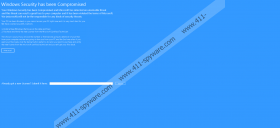''1-888-398-0888" Technical Support Scam Removal Guide
If your screen has been locked by the Windows Security has been Compromised window, it is a clear sign that you have encountered ''1-888-398-0888" Technical Support Scam. Cyber criminals usually use such scams to convince users to take action, for example, to call the provided telephone number. Most probably, this is the case with ''1-888-398-0888" Technical Support Scam too, but you should definitely not make a call because the alert you see on your screen is not genuine, we can promise you that. As a consequence, a bunch of problems might arise if you make a call. What should you do if you ever encounter ''1-888-398-0888" Technical Support Scam? Closing it is what you should do in the first place. Even though the window opened covers the entire screen and does not allow users to access their files and programs, it can be closed easily. You just need to press Alt+F4 on your keyboard. Once you can access your Desktop, make sure you take care of all malicious executables that are possibly associated with ''1-888-398-0888" Technical Support Scam. In other words, you must delete them all so that the irritating screen-sized window would not be opened on your screen again.
''1-888-398-0888" Technical Support Scam tries to convince users that the message they see has been opened by Microsoft, but we can assure you that this reputable company has nothing to do with this scam. It is just a fake security alert that tries to convince users that an “unsolvable threat” has been detected on their systems. As a consequence, their computers have been blocked. Users who fall victim to ''1-888-398-0888" Technical Support Scam are also provided with two options they can choose from: 1) reinstall Windows or 2) purchase a new license from a certified Microsoft Technician. Users are also warned that all their files will be removed if they opt for the first option. Evidently, scammers want you to choose the second option, i.e. contact “technicians” to get a new license. If you do as expected, i.e. dial 1-888-398-088 (keep in mind that you might be presented with another telephone number), scammers will pick up the phone and then convince you to pay money for the license you do not need. When you close the window representing ''1-888-398-0888" Technical Support Scam, you will see for yourself that your Windows OS runs smoothly. Also, cyber criminals might try to trick you into giving them remote access to the system so that they could steal information from the affected computer or install malicious software on it. Finally, if you make a call, your telephone bill might increase considerably. Believe us, there is no point in dialing the number you see – you will remove the window opened on the screen yourself without difficulty.
Researchers working at 411-spyware.com say that the majority of users encounter ''1-888-398-0888" Technical Support Scam after they open a malicious attachment from an email received. It is no longer a secret that attachments might drop malware on PCs, but users still tend to open them out of curiosity. This is, actually, a huge mistake they make. You should quit this bad habit today if you do not want to encounter even more serious malicious applications in the near future. No, the malicious application that has opened the fake security alert on your screen is definitely not the only one that can be encountered after opening a malicious email attachment. We suspect that you are not the most experienced user if you are reading this article, so we also highly recommend that you install a security application on your PC so that those infections you do not recognize yourself could not slither onto your computer without your knowledge.
''1-888-398-0888" Technical Support Scam does not have a point of execution, which means that you will not find a fake warning opened on your screen again after the system restart unless you launch the malicious file again. It does not mean that you can keep this file on your system because you can launch it accidentally again. Even though you do not know how it is called, we are sure you will get rid of it by deleting all recently downloaded files. You could do that only after you close the opened window.
How to get rid of ''1-888-398-0888" Technical Support Scam
- Tap Alt+F4 to close the fake security alert.
- Delete all suspicious files downloaded recently.
- Empty Trash.
''1-888-398-0888" Technical Support Scam Screenshots:


